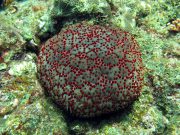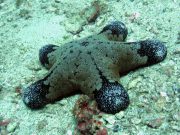Diving with Cushion Stars and Allies
Lanta Marine Life | Oreasteridae
The Cushion Stars and Allies contains 29 genera and 263 species of sea stars, around one sixth of the known species of sea stars. They can be found at all sites on our Koh Lanta diving trips.
Many species within this large family are traditional sea stars, usually with 5 arms surrounding a thick, brightly coloured body with a central 'dome' which can often look as though it has been inflated.
The upper surface of Cushion Stars can be granular, spiny or smooth. They have rows of tube feet on their lower side which are located within a v-shaped groove and are used for movement. These tube feed may be sucker-tipped or pointed.
The gut of a starfish occupies most of the disc and extends into the arms. The mouth is located at the centre of the lower surface, feeding mostly on bottom-dwelling invertebrates.
Most sea stars can regenerate lost arms or damaged parts and they can shed arms as a means of defence.
Although starfish do not have much in the way of sense organs, they are sensitive to touch, light, temperature, orientation and the status of the water around them. The tube feet, particularly those at the tips of the arms, are able to sense odour sources such as food.
2 species found on this page:
Cushion Sea Star
(Culcita novaeguineae)
The Cushion Sea Star has very short arms and a large, inflated pentagonal (five sided) body. There are 5 rows of short tube feet on the underside which can be retracted into the hard, armoured body. The mouth is in the middle of the underside, and the body is inflated with water. When out of water, the body can be deflated to give more of a ‘star’ shape.
This sea star is variably coloured, and includes mottling with darker and lighter shades of fawn, brown, orange, yellow and green. The upper side has a texture of bumps and small circular shapes.

Culcita novaeguineae @ Koh Haa
Juvenile Cushion Sea Star are flat, olive coloured and star-shaped, with five short arms in the range 5 cm - 8 cm. As they grow, the inter-arm areas are filled by the expanding central disc until the appear almost non-existent.
Adults grow to 25 cm and feed nocturnally on hard corals, especially branching corals (family Acropora) and cauliflower or brush corals (family Pocillopora). It is little known that Cushion Sea Stars have very similar feeding habits to Common Crown-of-Thorns Sea Stars (Acanthaster planci).
Granular Sea Star
(Choriaster granulatus)

Choriaster granulatus @ Koh Bida
The Granular Sea Star is usually a brownish to tan colour, sometimes orangish-brown, the short stubby arms with either lighter, or darker coloured tips. The body is covered with many clumps of papillae (small body outgrowths) and irregular rows of blotched patterns radiating from the center.
The Granular Sea Star grows to 25 cm and feeds similarly to other sea stars, with the mouth on the underside of the body, the digestive organs are forced out of the stomach so that they prey can be absorbed outside the body, and includes coral polyps, small invertebrates and other organic material.
Diving with Cushion Stars and Allies around Koh Lanta
Scuba Diving & Snorkel Trips
If you'd love a chance to spot Cushion Stars and Allies on one of our daily high season diving trips from Koh Lanta then send us an email to info@diveandrelax.com.
Join our high season speedboat dive trips to some of Thailand's best dive sites and enjoy small groups, short journey times, with a focus on great personal service, safety and fun.
Not yet a certified diver? Learn to Scuba Dive on Koh Lanta with the 3 day SSI Open Water Diver course.
Book online to save 10% on dive trips and scuba courses on Koh Lanta.
Find Out More
Indo-Pacific Marine Life Guides
- Allen, G., Steene, R., Humann, P., DeLoach, N. (2003) Reef Fish Identification, Tropical Pacific. Jacksonville, FL., USA: New World Publications, Inc., ISBN 1-878348-36-1.
- Humann, P., DeLoach, N., (2010) Reef Creature Identification, Tropical Pacific. Jacksonville, FL., USA: New World Publications Inc., ISBN 978-1-878348-44-9
- Debelius, H. (2013) Indian Ocean Reef Guide. Frankfurt, Germany: IKAN - Unterwasserarchiv, ISBN 978-3-939767-52-7.
- Debelius, H. (2004) Nudibranchs and Sea Snails, Indo-Pacific Field Guide. Frankfurt, Germany: IKAN - Unterwasserarchiv, ISBN 3-925919-51-1
- Erhardt, H., Knop, D. (2015) Corals Indo-Pacific Field Guide. Frankfurt, Germany: IKAN - Unterwasserarchiv, ISBN 3-925919-69-4.
- Veron J.E.N., Stafford-Smith M.G., Turak E. and DeVantier L.M. (2016). Corals of the World


